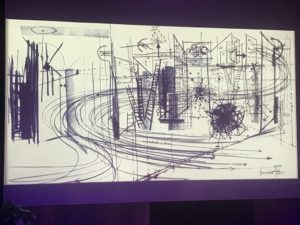essays , nr.5
megalomania
In 2009 vond in Wenen een fascinerende tentoonstelling plaats: ‘Modernism as a Ruin. An Archaeology of the Present”; niet alleen een her-denken van modernistische ideeën en plannen welke als doel hadden een meer humane samenleving te bewerkstelligen, maar bovenal het bevragen van de status van deze – vaak vermeende – utopia. Opvallend genoeg waren meerdere getoonde/besproken projecten (werk van o.a. Gordon Matta-Clark, Robert Smithson, Rob Voerman) in hun achtergrond en opzet visionair: als voorbeeld mag het werk van Yona Friedman worden genoemd. Zijn ‘Ville Spatiale’-modellen uit 1959 zijn ontworpen op basis van uitgangspunten en aannames (in Friedman’s woorden ‘grand illusions’) die nu opnieuw – of nog altijd – van groot belang blijken.
Deze aandacht lijkt opnieuw gerechtvaardigd nu, na nog altijd veel scepsis en kritiek een opzienbarende visie in het Midden-Oosten voorbij de schetsfase en tekentafel is gekomen. Daarnaast; ook in ons land verschijnen regelmatig studies voor een samenleving en inrichting die verwachte ontwikkelingen uitwerkt tot soms futuristische – utopische? – beelden waarbij de terugkerende vraag is: wat is haalbaar; hoever vooruit willen/kunnen we denken?
Is het een megalomaan experiment, een futuristische ingreep in het barre woestijnlandschap, een fascinerende visie op een toekomstige samenleving of een bijna letterlijke streep door de menselijkheid? Voor wie denkt dat project ‘The Line’ in het uiterste noordwesten van Saudi Arabië slechts een abstracte utopie dan wel gevreesde dystopie is; het land is begonnen met de uitwerking en realisatie. Dit immense project bestaat uit de kunstmatige, vooral verticale ‘stad’ van 34 km2., die met een lengte van 170 km., een breedte van 200 m. uiteindelijk volgens plan plaats moet bieden aan 9 miljoen inwoners. Inmiddels is dit laatste cijfer naar beneden bijgesteld en zijn veel medewerkers aan het project ‘overgeplaatst’. Volgens de website is hier sprake van een ‘civilizational revolution that puts human’s first’ , draait de stad voor 100% op ‘renewable energy’ en wordt 95% van het land ‘preserved for nature’. De buitenzijden aan weerskanten spiegelen de omringende woestijn en doen het voorkomen alsof de ‘stad’ een fata morgana is; alle leven vindt plaats binnen deze vrijwel hermetische afzondering van de buitenwereld, tussen wanden van 500 meter hoog. Hier is geen sprake van een organisch groeiende stad, gebouwd en bewoond op basis van een historische context of een economische basis. Hier is geen andere perceptie dan die van de ‘overzijde’, er is geen – visueel – contact met de natuurlijke wereld buiten de hoge muren. Het impliceert dat bewoners letterlijk in een grootschalig keurslijf worden gedwongen; in een bestaan dat zich vrijwel uitsluitend afspeelt binnen de gecreëerde fysieke/artificiële kaders.
De Amerikaanse schrijver/urbanist Adam Greenfield stelde al in november 2022 met een uiters kritisch artikel in ‘Dezeen’ dat ‘all those complicit in NEOM’s design and construction are already destroyers of worlds’. Het weerhoudt wereldwijd een aantal grote architecten- en ontwerpbureau’s vooralsnog niet om te participeren. Lees verder

